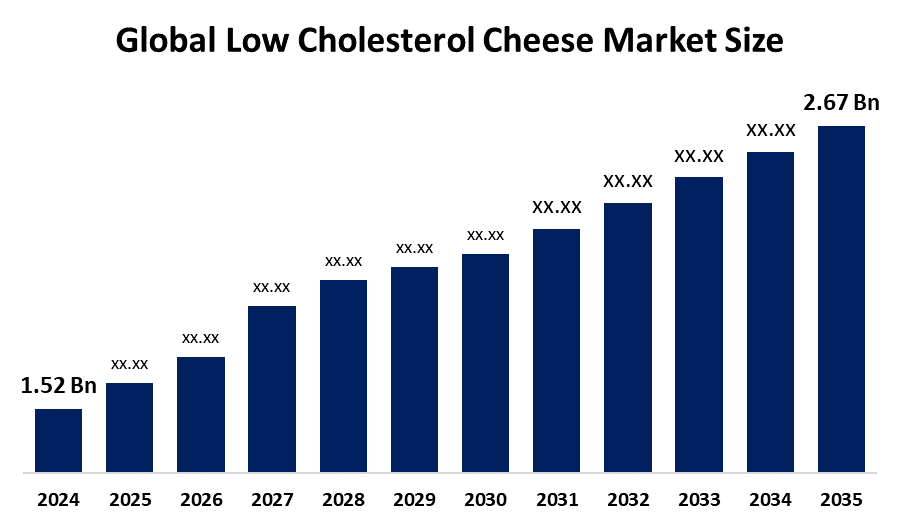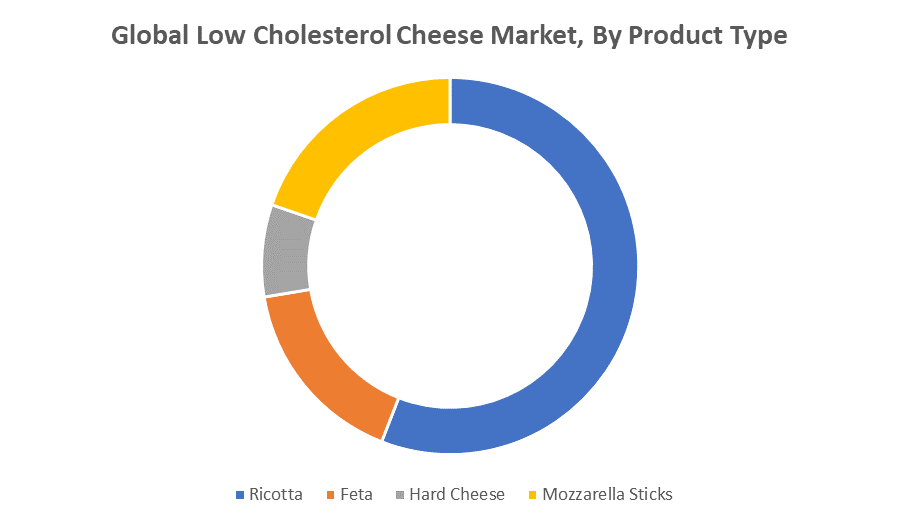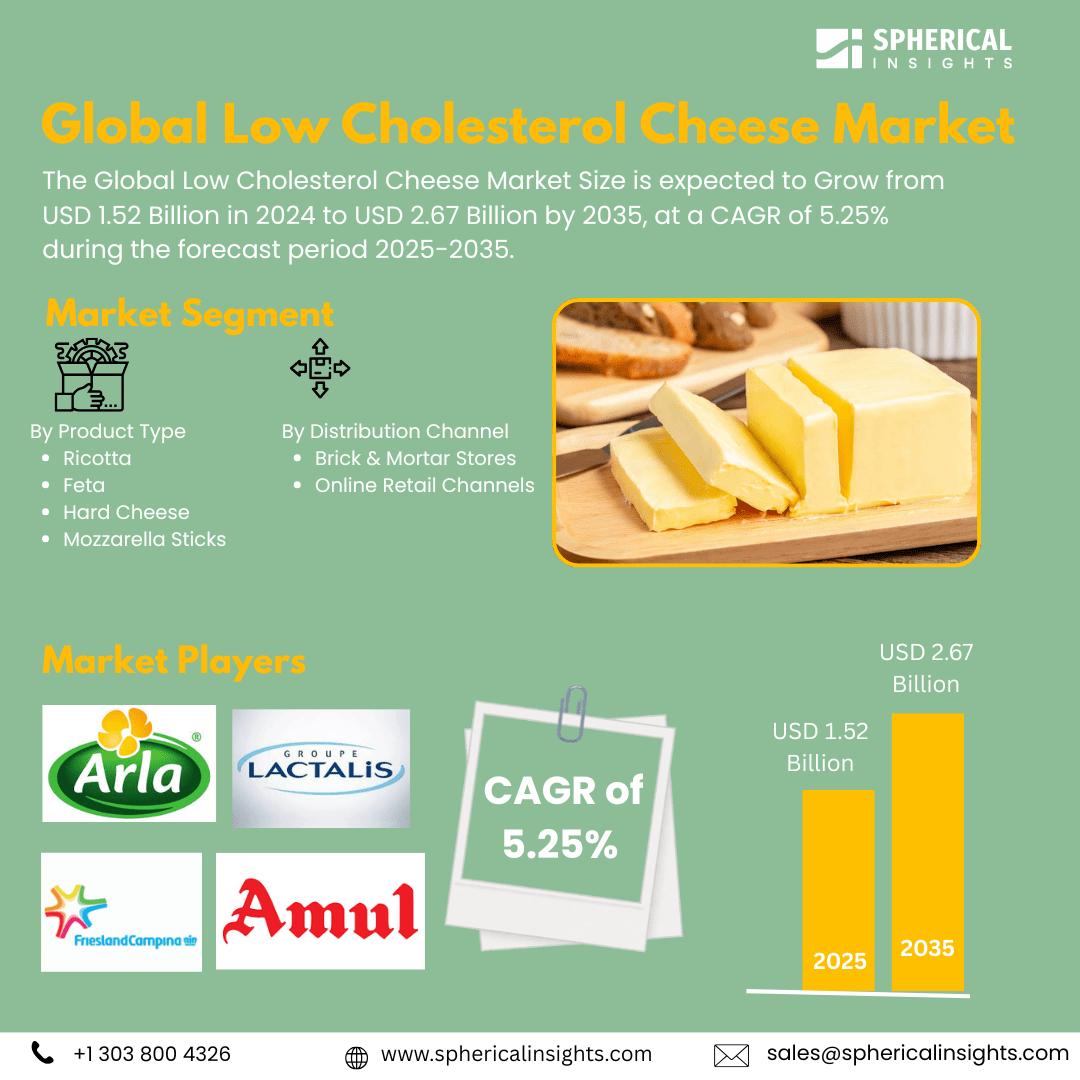Global Low Cholesterol Cheese Market Insights Forecasts to 2035
- The Global Low Cholesterol Cheese Market Size Was Estimated at USD 1.52 Billion in 2024
- The Market Size is Expected to Grow at a CAGR of around 5.25% from 2025 to 2035
- The Worldwide Low Cholesterol Cheese Market Size is Expected to Reach USD 2.67 Billion by 2035
- Asia Pacific is expected to grow the fastest during the forecast period.

Low Cholesterol Cheese Market
The global low cholesterol cheese market is experiencing steady growth due to rising health consciousness and increased demand for heart-friendly dairy alternatives. Low cholesterol cheese, made with reduced-fat milk or plant-based ingredients, caters to consumers aiming to manage cholesterol levels without sacrificing flavor. This market includes products like low-fat cheddar, mozzarella, and cottage cheese. Governments worldwide are encouraging healthier eating habits through public health campaigns and nutritional labeling regulations, further fueling demand. For instance, initiatives like the U.S. FDA’s “Nutrition Innovation Strategy” and the EU’s “Farm to Fork” strategy promote reduced fat and cholesterol intake. Additionally, rising incidences of cardiovascular diseases and obesity are pushing consumers toward healthier dietary choices. The market is witnessing innovation in taste and texture, making low cholesterol cheese increasingly appealing. Key players are investing in R&D and marketing to capture a larger share of the evolving functional foods and dairy alternatives market globally.
Attractive Opportunities in the Low Cholesterol Cheese Market
- Collaborating with fitness brands, nutritionists, and wellness influencers presents a strong opportunity to position low cholesterol cheese as a vital part of a balanced, health-focused lifestyle. These partnerships can enhance brand credibility, expand consumer reach, and tap into the growing health-conscious and diet-specific consumer segments.
- Emerging markets in Asia-Pacific and Latin America are witnessing rising health awareness and disposable incomes, creating fresh demand for low cholesterol cheese. Leveraging direct-to-consumer sales models and online retail platforms can increase accessibility and engagement, helping brands rapidly capture market share in these fast-growing regions.
Global Low Cholesterol Cheese Market Dynamics
DRIVER: Growing demand for functional and low-fat dairy products
Rising incidences of cardiovascular diseases have led consumers to seek healthier food alternatives. Growing demand for functional and low-fat dairy products, coupled with the global shift toward preventive healthcare, supports market expansion. Government initiatives promoting low-cholesterol diets and clearer food labeling also influence consumer choices. Additionally, innovation in food technology enables better taste and texture in low-fat cheeses, enhancing consumer acceptance. Expanding vegan and lactose-intolerant populations further boost demand for plant-based, low-cholesterol cheese alternatives across various regions.
RESTRAINT: Limited awareness in developing regions
One major challenge is the higher production cost associated with developing low-fat, cholesterol-reduced cheese without compromising taste or texture. These products often require specialized ingredients and processing, leading to higher retail prices that can deter price-sensitive consumers. Additionally, limited awareness in developing regions and consumer skepticism regarding the taste and nutritional value of low cholesterol cheese can hinder market growth. The availability of substitutes, such as plant-based or traditional low-fat dairy products, also intensifies competition, making it harder for low cholesterol cheese to gain widespread acceptance.
OPPORTUNITY: Strategic partnerships with fitness brands
Advancements in food science now allow for the creation of flavorful, low-cholesterol cheeses using innovative ingredients like plant-based proteins and fermented alternatives. This creates room for premium and specialty product lines targeting health-conscious and diet-specific consumers. Emerging markets, particularly in Asia and Latin America, are witnessing a surge in health awareness, offering fresh ground for market expansion. Direct-to-consumer models through digital platforms and health-focused online retailers enhance reach and consumer engagement. Moreover, strategic partnerships with fitness brands, nutritionists, and wellness influencers can position low cholesterol cheese as an essential part of a balanced, modern lifestyle.
CHALLENGES: Competition from other health-focused dairy
Achieving desirable taste and texture while maintaining low cholesterol levels remains difficult, affecting consumer satisfaction. Limited awareness and acceptance in developing regions slow market penetration. Additionally, competition from other health-focused dairy and plant-based alternatives puts pressure on pricing and differentiation. Regulatory complexities and varying food standards across countries also hinder consistent product development and global expansion for manufacturers.
Global Low Cholesterol Cheese Market Ecosystem Analysis
The global low cholesterol cheese market ecosystem includes key players such as dairy producers, food-tech innovators, and plant-based competitors, all focused on developing heart-healthy, flavorful products. Ingredient suppliers and technology firms support innovation in taste, texture, and nutrition. Distribution spans supermarkets, e-commerce, and foodservice channels. Regulatory bodies and health advocates influence labeling and consumer trust. Rising health consciousness, especially in emerging markets, drives demand. Success relies on aligning product development, affordability, and accessibility with evolving consumer preferences and global wellness trends.
Based on the product type, the ricotta segment led the market with the leading revenue share over the forecast period

Ricotta's dominance is attributed to its widespread culinary use, soft texture, and consumer perception as a healthier, protein-rich cheese with lower fat content compared to hard cheeses. Its versatility in both sweet and savory dishes has fueled consistent demand across various regions. Additionally, Ricotta aligns well with health-conscious dietary trends, making it a preferred choice in the low cholesterol cheese segment.
Based on the distribution channel, the brick & mortar stores segment led the market with the major revenue share over the forecast period
Traditional retail outlets like supermarkets, hypermarkets, and convenience stores remain the dominant sales channels due to their wide reach, product variety, and consumer preference for in-person shopping, especially for perishable items like cheese. Although online retail channels are growing rapidly, driven by convenience and expanding e-commerce penetration, they have not yet surpassed brick & mortar stores in revenue share during the forecast period.
North America is anticipated to hold the largest market share of the low cholesterol cheese market during the forecast period
North America is anticipated to hold the largest market share of the low cholesterol cheese market during the forecast period. This leadership is driven by high consumer awareness of heart health, widespread adoption of healthier diets, and strong presence of key market players. Additionally, advanced retail infrastructure, government initiatives promoting low-fat and low-cholesterol products, and rising incidences of cardiovascular diseases contribute to robust demand. The region’s developed food technology sector also supports product innovation, further solidifying North America’s dominance in the low cholesterol cheese market.
Asia Pacific is expected to grow at the fastest CAGR in the low cholesterol cheese market during the forecast period
Asia Pacific is expected to grow at the fastest CAGR in the low cholesterol cheese market during the forecast period. This rapid growth is fueled by rising health awareness, increasing disposable incomes, and changing dietary habits in countries like China, India, Japan, and Southeast Asia. Urbanization and Westernization of diets are driving demand for healthier cheese alternatives. Additionally, expanding retail networks, growing e-commerce penetration, and supportive government health initiatives further accelerate market expansion in this region. The increasing prevalence of lifestyle diseases also motivates consumers to opt for low cholesterol cheese products.
Recent Development
- In September 2024, Cathedral City (UK) launched a high-protein, half-fat cheddar cheese range, providing 30g protein per 100g with 50% less fat than regular cheddar. Available in blocks, slices, grated, and mini formats, it targets health-conscious consumers seeking taste and nutrition.
Key Market Players
KEY PLAYERS IN THE LOW CHOLESTEROL CHEESE MARKET INCLUDE
- Amul
- Arla Foods
- FrieslandCampina
- Lactalis Group
- Britannia Industries
- Crystal Farms
- Bongrain
- Bel Group
- Eatlean
- Cathedral City
- Others
Market Segment
This study forecasts revenue at global, regional, and country levels from 2020 to 2035. Spherical Insights has segmented the low cholesterol cheese market based on the below-mentioned segments:
Global Low Cholesterol Cheese Market, By Product Type
- Ricotta
- Feta
- Hard Cheese
- Mozzarella Sticks
Global Low Cholesterol Cheese Market, By Distribution Channel
- Brick & Mortar Stores
- Online Retail Channels
Global Low Cholesterol Cheese Market, By Regional Analysis
- North America
- Europe
- Germany
- UK
- France
- Italy
- Spain
- Russia
- Rest of Europe
- Asia Pacific
- China
- Japan
- India
- South Korea
- Australia
- Rest of Asia Pacific
- South America
- Brazil
- Argentina
- Rest of South America
- Middle East & Africa
- UAE
- Saudi Arabia
- Qatar
- South Africa
- Rest of the Middle East & Africa
FAQs
Q: Which product segment leads the Global Low Cholesterol Cheese Market?
A: The Ricotta segment leads the market with the largest revenue share due to its soft texture, versatility, and health benefits.
Q: Which distribution channel dominates the Global Low Cholesterol Cheese Market?
A: Brick & mortar stores dominate the market with the highest revenue share during the forecast period.
Q: Which region holds the largest market share in the Global Low Cholesterol Cheese Market?
A: North America is anticipated to hold the largest market share due to high health awareness and strong retail infrastructure.
Q: Which region is expected to grow the fastest in the Global Low Cholesterol Cheese Market?
A: Asia Pacific is expected to grow at the fastest CAGR, driven by rising health awareness, disposable incomes, and urbanization.
Q: What are the main drivers of growth in the Low Cholesterol Cheese Market?
A: Rising cardiovascular diseases, growing demand for functional and low-fat dairy products, government health initiatives, and food technology innovations drive market growth.
Q: What challenges are limiting the adoption of Low Cholesterol Cheese products?
A: High production costs, limited consumer awareness in developing regions, competition from other dairy and plant-based alternatives, and regulatory complexities are key challenges.
Q: What opportunities exist in the Global Low Cholesterol Cheese Market?
A: Strategic partnerships with fitness brands, nutritionists, and wellness influencers, as well as expansion in emerging markets and direct-to-consumer digital sales models, present attractive growth opportunities.
Q: What recent product development has occurred in the Low Cholesterol Cheese Market?
A: In September 2024, Cathedral City launched a high-protein, half-fat cheddar cheese range with 50% less fat and 30g protein per 100g, targeting health-conscious consumers.
Q: Which application segments are driving demand for low cholesterol cheese?
A: Functional foods and health-focused dairy alternatives are driving demand, supported by consumers focusing on heart health and balanced diets.
Q: How are government initiatives influencing the Low Cholesterol Cheese Market?
A: Programs like the U.S. FDA’s Nutrition Innovation Strategy and the EU’s Farm to Fork strategy promote reduced fat and cholesterol intake, boosting market demand.





